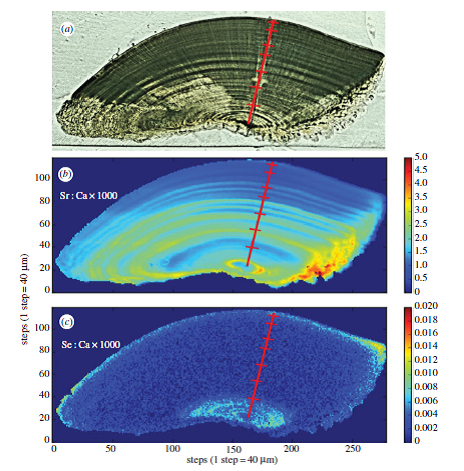X-RAY RUNS: Apply for Beamtime
2017 Nov 1 - Dec 21
2018 Feb 7 - Apr 3
2018 Proposal/BTR deadline: 12/1/17
2018 Apr 11 - Jun 4
2018 Proposal/BTR deadline: 2/1/18
There is great need to study the life history of commercial fishes in the Amazon and other large South American basins, as there are dozens of exploited taxa with widely varying life histories that are poorly understood. The Amazon Basin is a complex network of interconnected terrestrial and aquatic environments, with chemical diversity dictated by the bedrocks and soils through which river tributaries pass. Overfishing has led to considerable declines in some species, while deforestation is producing stronger, earlier flood pulses, altering the flood cycle that migratory fishes rely upon.
Otolith microchemistry offers a practical, cost-effective means of studying fish life history in such a system. On the contrary, mark–recapture studies are prohibitively expensive in large or remote systems, while fish in tagging studies are often intensely harvested by fishermen or migrate distances too great to study with these methods.
Otoliths, the calcified ear-stone organs in fish hearing/balance systems, are metabolically inert, recording information over a fish’s entire life. Otolith incremental deposition forms the basis of age and growth studies, and incorporated elements provide information on the life history and environment. Theodore W. Hermann, Donald J. Stewart, Karin E. Limburg (SUNY College of Environmental Science and Forestry), and Leandro Castello (Virginia Tech), used CHESS F3 beamline scanning X-ray fluorescence microscopy (SXFM), together with laser ablation–inductively coupled plasma mass spectrometry (LA–ICPMS), to sample a multitude of elements simultaneously in Amazon fish otoliths [1]. Their studies on fish otoliths confirmed fish life history and migrations, found otolith markers indicating migrations between chemically distinct environments, also found evidence of pollution exposure in some fish, and also found possible new markers for their otolith studies. In their words, their discoveries in such studies “introduce what should be a productive line of research desperately needed to better understand the migrations of these unique and imperiled fishes”.
 Optical image (a) and X-ray fluorescence 2D mapping of an otolith of 3.5 year old Brachyplatystoma rousseauxii, revealed its alternating bands of Se and Sr that were delineated by biannual growth checks. Marked Se deposition co-occurred with rapid growth in the early life. Sr : Ca indicated two distinct life-history phases: one marked by high, variable Sr : Ca during the first 1.5–2 years of life followed by a phase marked by lower, less variable Sr : Ca.
Optical image (a) and X-ray fluorescence 2D mapping of an otolith of 3.5 year old Brachyplatystoma rousseauxii, revealed its alternating bands of Se and Sr that were delineated by biannual growth checks. Marked Se deposition co-occurred with rapid growth in the early life. Sr : Ca indicated two distinct life-history phases: one marked by high, variable Sr : Ca during the first 1.5–2 years of life followed by a phase marked by lower, less variable Sr : Ca.
Reference:
[1] Theodore W. Hermann, Donald J. Stewart, Karin E. Limburg and Leandro Castello, “Unravelling the life history of Amazonian fishes through otolith microchemistry”, Royal Society of Open Science, 3: 160206. http://rsos.royalsocietypublishing.org/content/royopensci/3/6/160206.full.pdf
Submitted by: Rong Huang, CHESS, Cornell University
12/20/2016
